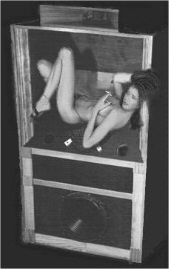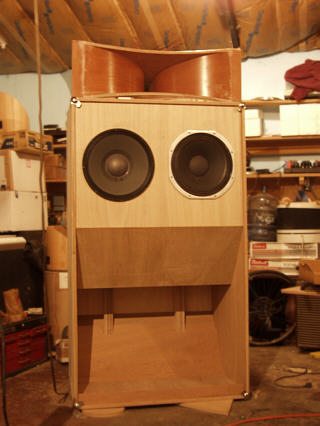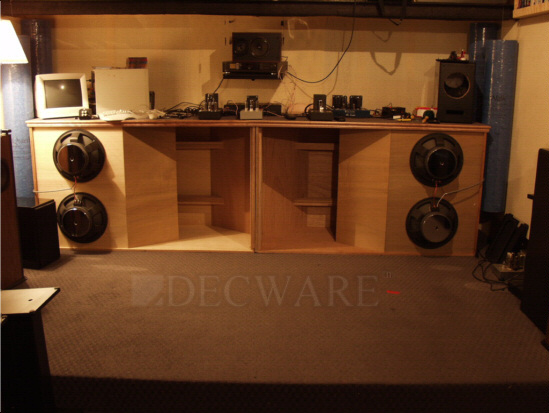|
The
Redesigned 1956
Jensen Imperial
The original Jensen
Imperial started back in
the days before Stereo when people listened
only in mono. Speakers were
sold as raw components and consumers built
their own enclosures or
had them built. My introduction to it came about 20 years ago when a fellow carpenter and I were finishing a house. He showed me an old book with speaker plans and had the page marked for the one he wanted ME to build. Why me? In his own words... "it's so big my wife would see me building it so you're going to have to do it." He also informed me he wanted TWO of them. I studied the page and tried to imagine how big it would actually be... about the size of a commercial refrigerator! Then I tried to imagine what it would sound like and that's all it took. I built our first pair, and the fun began. It lasted about 2 years as we tried every possible combination of drivers we could think of. We discovered right away that A) the box was very particular about the type of woofer you used. B) the engineers who designed it in 1956 didn't bother to see what happens when you dump 800 watts into a pair! Along the journey we quickly found out that nothing man made that you could buy in any stereo shop could ever come remotely close to this cabinet as a sub-woofer. It would make bass come out of almost anything. A 25 watt 10 inch pioneer woofer shook items off a neighbors shelf in the house across the street. Distance: 220 feet. It did that with one channel of a 22 watt class AB receiver. The same woofer in the box it came out of with the same signal wouldn't shake a pencil, in fact, by comparison it was inaudible. It was in that moment I saw the light. It's been almost 20 years since and the passion it ignited actually created DECWARE. Since then, I've had the opportunity to hear most of the best speakers in the world. I bring that up because even today with all I've heard nothing in the consumer marketplace that's not custom built seems to be able to kick its ass. In the years that followed we built several more of these cabinets and used them as sub-woofers in large night clubs. This continued R&D gave us the opportunity to try a variety of things that otherwise would have been too costly. You're probably thinking who needs a bunch of thick heavy bass - night clubs always have sucky bass. Well, ironically the bass from the Imperial was just the opposite. Fast and effortless it was the benchmark of clean, flat, low bass On one occasion a club owner wanted to hear what one would do in his own place so he called us up. On the spur of the moment we had to take what we had so we packed up a single Imperial, my frequency generator, and an old Harmon Kardon Receiver with one channel blown. Just before we got this call, we had been experimenting with a unique driver arrangement. We removed the 15 inch woofer, and replaced it with a 12 inch woofer that was already mounted in a 1 cubic foot sealed cube. The response of the woofer in the cube was 3 dB down at 120 cycles. Basically ZERO bass. We installed this cube into the Imperial with the woofer facing the back of the enclosure. The original 15 inch speaker opening was sealed. Installed the response was a bit different. Starting at the same 120 cycles and measuring the SPL at 90 dB in the room we slowly started to sweep the frequencies down until at 28.5 cycles the SPL had risen to 118 dB. That's a 28 dB of gain at 28.5 cycles! I really can't begin to describe what happens at that frequency when you hit that SPL, but it's serious. We saw a mouse stagger out of a crack in the concrete floor and die. We gave the same demonstration in the night club for its owner, using only a single 12 inch woofer and 80 watts we were able to move the ash trays on 51 tables throughout the facility. It was an effective demonstration. He bought it, and we placed it into service with the 12 inch woofer that you couldn't move for the sealed box behind it - just to see how long it would last with 800 watts driving it all night long. The woofer lasted about 1 week and we got a service call. Upon inspection I was shocked to see 1/2 of the pulp speaker cone missing. It was all still inside the cube in the form of a powder. The largest fragment was less than 10 millimeters across. We saved that woofer for over 10 years just to look at it. And frankly the stories go on and on and on and on. The speaker casts a spell on people - even before it's played.
THE MODIFICATIONS After building several pairs of these speakers and flexing their muscles some very obvious design flaws reared their ugly head and we found ourselves having to stiffen up the cabinets on every one. Many years passed and as always we sold our personal pairs along the way and hadn't had a good Imperial buzz for a long time so we decided this Christmas to make one more pair for ourselves. We've had ideas about how to modify the design to elevate the resonance issues and make it less finicky about woofer types. Also learned a lot about how to handle the mids and highs on full range applications so it was time to pull it all together and redesign the cabinet. If you've ever built this imperial from the original Jensen plans you've probably had a few ill thoughts about the guy that drew the plans as you work out the discrepancies between angles and panel sizes.
As you can see the new design uses two 15 inch drivers rather than one. There is also a high frequency horn on top of the cabinet. Of course there are several ways to configure this cabinet. Two drivers are optional, the high frequency horn is optional.
APPLICATIONS Before you build one or a pair of these speakers you really should know the intended application of which there are three.
In all applications there is one consistency - the room must be large. 24 x 24 feet is really about the minimum and frankly rooms 2 to 4 times this size would be less problematic.
ACOUSTICS These horns launch a very large wave front below 600 Hz. That makes bass response difficult to handle when compared to a smaller speaker. A smaller speaker having a tiny wave front creates dozens of nodes or pockets in your listening space where cancellation has created quiet or soft spots in the low frequency response. This is common with all speakers used in smaller residential listening rooms. It also makes it possible to arrange your speakers and listening chair so that you are not sitting in one of these nodes, the result being a frequency balance that has solid bass response. If you were to increase the wave front launching from the speaker to say 30 times it's original size, it would fill the room with greatly simplified cancellation, ie. less nodes. That might sound good, but it is actually bad because rather than resulting in dozens of complex standing waves that create the pockets where you will hear some bass, a large simple standing wave will have near perfect cancellation. The result is less pockets, and each pocket becoming very large. That makes it difficult to hear any low bass response when you are in the center area of the room. In fact you will probably have to sit against the back wall to hear any bass. In a perfectly square room it is possible to create an almost perfect standing wave. To listen to one is a puzzlement, because it is no different than having a 24dB active crossover set at 80 Hz. If you go outside your house or to the other end of your house it becomes quiet a different story. There you will hear the bass. To prevent not hearing the bass from a speaker like this with a reputation for being a benchmark in low frequency response, you MUST take your room into account. Having lots of clutter in a small room, combined with plenty of bass traps is the best approach. In a large space the urgency for room preparation is less of an issue.
CABINET SIZE = 28 cubic feet each. Approx Dimensions 62" x 38" x 28" Materials need are 3/4" plywood, we recommend mahogany, and lots of carpenter's wood glue. An air nailer with 2" finish nails makes life a little easier during construction. Each unit takes between 5 and 6 4 x 8 sheets of plywood.
Decware is a
trademark of High Fidelity
Engineering Co. |

 Fortunately
we've built
enough of them now to get a good feel for what
works best. We
made some fundamental changes to the cabinet
construction that make
layout and assembly much easier. This modified
design has many
advantages. It is stronger, it has less
distortion, faster
transient response, higher efficiency, flatter
frequency response and
can accommodate a larger selection of 15 inch
drivers. The only
thing that stayed the same is the final horn
flare itself which bends
waves up to 600 cycles.
Fortunately
we've built
enough of them now to get a good feel for what
works best. We
made some fundamental changes to the cabinet
construction that make
layout and assembly much easier. This modified
design has many
advantages. It is stronger, it has less
distortion, faster
transient response, higher efficiency, flatter
frequency response and
can accommodate a larger selection of 15 inch
drivers. The only
thing that stayed the same is the final horn
flare itself which bends
waves up to 600 cycles.
